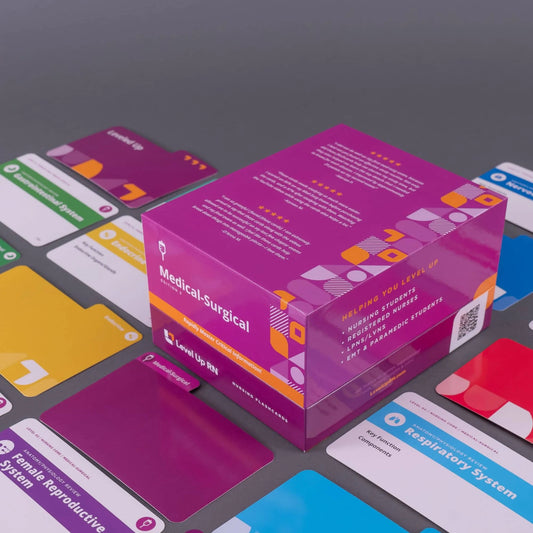In this article, we cover migraine headaches vs. cluster headaches.
The Med-Surg Nursing video series follows along with our Medical-Surgical Nursing Flashcards, which are intended to help RN and PN nursing students study for nursing school exams, including the ATI, HESI, and NCLEX.
Medical-Surgical Nursing - Flashcards
Migraine Headaches
A migraine headache is a neurovascular disorder that causes unilateral (on one side) throbbing head pain.
Migraines typically last 4-72 hours. For 15-30% of patients, that head pain may be preceded by an aura.
What is an aura in migraines?
An aura, as it pertains to migraines, is a visual or sensory disturbance. In the video, Cathy describes how she experienced a weird, flashing-light sensation over one of her eyes while she was driving! She got to school safely (but if this happens to you, pull over where it's safe). On the advice of her nursing school professor, Cathy acted proactively and took ibuprofen with a large coffee, which did help.
Pathophysiology
The pathophysiology behind migraine headaches is poorly understood. It's believed to be caused by activation of cranial nerve 5 and cerebral arterial vasodilation. Because of the vasodilation, the treatments discussed later in this article aim to cause vasoconstriction.
Risk Factors
A family history of migraines is a risk factor for experiencing migraines. Also, women are more likely to experience migraine headaches than men.
Triggers
Migraine triggers include bright/flashing lights, stress, anxiety, menstrual cycles, sleep deprivation, and certain foods. Foods containing MSG or tyramines can trigger migraines in some people.
Signs/Symptoms
Patients who have a migraine usually experience throbbing head pain, nausea, vomiting, photophobia (sensitivity to light), phonophobia (sensitivity to noise), or an aura.
Treatment
For a mild migraine, the treatment is usually NSAIDs like ibuprofen. If a patient has severe migraine, then medications like ergotamine and sumatriptan can be used. These medications' mode of actions are to cause vasoconstriction in the cerebral arteries. Caffeine can also be helpful, like in Cathy's story, because it is also a vasoconstrictor.
Antiemetics can be used for nausea and vomiting.
For patients with recurring migraines, prophylactic medications may be needed. This might include antihypertensives or anticonvulsants to help prevent the onset of migraines.
Nursing Care
In terms of nursing care and patient teaching for migraines, you should instruct your patient to lay down in a dark, quiet environment if they are experiencing a migraine. This will help with the photophobia and phonophobia. They should also avoid triggers, so reducing their stress level if possible, and avoiding foods that may trigger a migraine.
Cluster Headaches
A cluster headache is a neurovascular disorder that causes unilateral, non-throbbing head pain that typically lasts between 30 minutes and two hours. It typically happens at the same time of day for months and is more common in the spring and fall (rather than summer or winter).
Pathophysiology
The pathophysiology of cluster headaches is poorly understood, just like it is for migraine headaches. However, cluster headaches are thought to be caused by the sudden release of histamine or serotonin at cranial nerve 5, which is the trigeminal nerve.
Signs/Symptoms
The signs and symptoms of cluster headaches include severe, unilateral,non-throbbing head pain, and it typically happens around the orbital region. In addition to non-throbbing pain, the patient will also likely experience nasal congestion, facial sweating, a droopy eyelid, excess tearing in their eyes, agitation and pacing.
Treatment
Ergotamine and sumatriptan, which are used to treat migraines, can also be effective at treating cluster headaches. There are other treatment options aimed at cluster headaches, which include oxygen therapy, corticosteroids, and verapamil, which is a calcium channel blocker.



1 comment
Med-Surg – Nervous System, part 6: Migraine and Cluster Headaches" offers a comprehensive exploration of these debilitating conditions, shedding light on their complexities and treatment options. This website’s detailed coverage provides valuable insights for healthcare professionals and individuals alike, fostering understanding and better management of migraine and cluster headaches. Kudos to the website for its informative contribution to medical education and awareness.